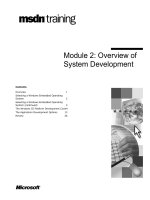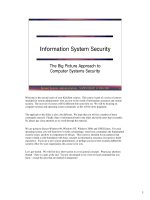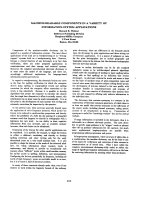Information system development traditional approach requirement
Bạn đang xem bản rút gọn của tài liệu. Xem và tải ngay bản đầy đủ của tài liệu tại đây (2.53 MB, 33 trang )
Matakuliah : M0054 Information System Development
Tahun : 2012
Topic 5
The Traditional
Approach Requirement
Rules
Read
active
Bina Nusantara
assignments
only
On time!
ask questions.
Requirements
On time!
Bina Nusantara
PERMISSION TO LEAVE
PROHIBITED
BEHAVIOUR
Traditional Approach Requirement
Points to discuss :
• Traditional vs. Object Oriented Approaches
• Requirements for the Traditional and OO
Approaches
• Data Flow Diagram
Bina Nusantara
Traditional vs. Object-Oriented
Approaches
Figure 6-1
Systems Analysis and Design in a Changing World, 5th
5
Requirements for the Traditional and
OO Approaches
Figure 6-2
Systems Analysis and Design in a Changing World, 5th
6
Data Flow Diagrams (DFDs)
• Graphical system model that shows all main
requirements for an IS in one diagram
– Inputs/outputs
– Processes
– Data storage
• Easy to read and understand with minimal training
Systems Analysis and Design in a Changing World, 5th
7
Data
Flow
Diagram
Symbols
Figure 6-3
Systems Analysis and Design in a Changing World, 5th
8
DFD Fragment Showing Use Case
Look Up Item Availability from the
RMO
Figure 6-4
Systems Analysis and Design in a Changing World, 5th
9
DFD Integrates Event Table and ERD
Figure 6-5
Systems Analysis and Design in a Changing World, 5th
10
DFD and Levels of Abstraction
• Data flow diagrams (DFDs) are decomposed into
additional diagrams to provide multiple levels of
detail
• Higher-level diagrams provide general views of
system
• Lower-level diagrams provide detailed views of
system
• Differing views are called levels of abstraction
Systems Analysis and Design in a Changing World, 5th
11
Layers of
DFD
Abstraction
for Course
Registratio
n System
Figure 6-6
Systems Analysis and Design in a Changing World, 5th
12
Context Diagrams
• DFD that summarizes all processing activity for the
system or subsystem
• Highest level (most abstract) view of system
• Shows system boundaries
• System scope is represented by a single process,
external agents, and all data flows into and out of
the system
Systems Analysis and Design in a Changing World, 5th
13
DFD Fragments
• Created for each use case in the event table
• Represent system response to one event within a
single process symbol
• Self-contained models
• Focus attention on single part of system
• Show only data stores required in the use case
Systems Analysis and Design in a Changing World, 5th
14
Three Separate DFD Fragments for Course
Registration System
Figure 6-7
Systems Analysis and Design in a Changing World, 5th
15
Event-Partitioned System Model
• DFD to model system requirements using single
process for each use case/activity in system or
subsystem
• Combines all DFD fragments together to show
decomposition of the context-level diagram
• Sometimes called “diagram 0”
• Used primarily as a presentation tool
• Decomposed into more detailed DFD fragments
Systems Analysis and Design in a Changing World, 5th
16
Combining
DFD
Fragments
to Create
EventPartitioned
System
Model
Figure 6-8
Systems Analysis and Design in a Changing World, 5th
17
Context
Diagram
for RMO
Customer
Support
System
Figure 6-9
Systems Analysis and Design in a Changing World, 5th
18
RMO Subsystems and Use
Cases/Activities from Event Table
Figure 6-10
Systems Analysis and Design in a Changing World, 5th
19
Context Diagram for RMO
Order-Entry Subsystem
Figure 6-11
Systems Analysis and Design in a Changing World, 5th
20
Five Separate DFD Fragments for
RMO
Order-Entry Subsystem
Figure 6-12
Systems Analysis and Design in a Changing World, 5th
21
Decomposing DFD Fragments
• Most DFD fragments can be further described
using structured English
• Sometimes DFD fragments need to be
diagrammed in more detail
• Decomposed into subprocesses in a detailed DFD
• DFD numbering scheme
– Hierarchical decomposition
• DFD Fragment 2 is decomposed into Diagram
2
• Diagram 2 has processes 2.1, 2.2, 2.3, 2.4
Systems Analysis and Design in a Changing World, 5th
22
Detailed
DFD for
Create
new
order
DFD
Fragment
Figure 6-14
Systems Analysis and Design in a Changing World, 5th
23
Physical and Logical DFDs
• Logical model
– Assumes implementation in perfect technology
– Does not tell how system is implemented
• Physical model
– Describes assumptions about implementation technology
– Developed in last stages of analysis or in early design
Systems Analysis and Design in a Changing World, 5th
24
Physical
DFD for
Schedulin
g Courses
Figure 6-15
Systems Analysis and Design in a Changing World, 5th
25









